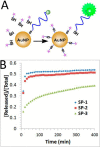Thermal stability of DNA functionalized gold nanoparticles
- PMID: 24102258
- PMCID: PMC3836601
- DOI: 10.1021/bc300687z
Thermal stability of DNA functionalized gold nanoparticles
Abstract
Therapeutic uses of DNA functionalized gold nanoparticles (DNA-AuNPs) have shown great potential and exciting opportunities for disease diagnostics and treatment. Maintaining stable conjugation between DNA oligonucleotides and gold nanoparticles under thermally stressed conditions is one of the critical aspects for any of the practical applications. We systematically studied the thermal stability of DNA-AuNPs as affected by organosulfur anchor groups and packing densities. Using a fluorescence assay to determine the kinetics of releasing DNA molecules from DNA-AuNPs, we observed an opposite trend between the temperature-induced and chemical-induced release of DNA from DNA-AuNPs when comparing the DNA-AuNPs that were constructed with different anchor groups. Specifically, the bidentate Au-S bond formed with cyclic disulfide was thermally less stable than those formed with thiol or acyclic disulfide. However, the same bidentate Au-S bond was chemically more stable under the treatment of competing thiols (mercaptohexanol or dithiothreitol). DNA packing density on AuNPs influenced the thermal stability of DNA-AuNPs at 37 °C, but this effect was minimum as temperature increased to 85 °C. With the improved understanding from these results, we were able to design a strategy to enhance the stability of DNA-AuNPs by conjugating double-stranded DNA to AuNPs through multiple thiol anchors.
Figures






References
-
- Rosi N. L.; Giljohann D. A.; Thaxton C. S.; Lytton-Jean A. K.; Han M. S.; Mirkin C. A. (2006) Oligonucleotide-modified gold nanoparticles for intracellular gene regulation. Science 312, 1027–1030. - PubMed
Publication types
MeSH terms
Substances
Grants and funding
LinkOut - more resources
Full Text Sources
Other Literature Sources

